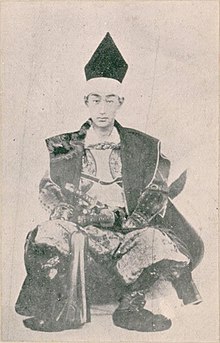Matsudaira Katamori
| Matsudaira Katamori | |
|---|---|

Matsudaira Katamori (1836–1893), photographed on the day of a cavalcade before Emperor Kōmei.
|
|
| Lord of Aizu | |
|
In office 1852–1868 |
|
| Preceded by | Matsudaira Katataka |
| Succeeded by | Matsudaira Nobunori |
| Kyoto Protector | |
|
In office 1863–1864 |
|
| Preceded by | None |
| Succeeded by | Matsudaira Yoshinaga |
|
In office 1864–1867 |
|
| Preceded by | Matsudaira Yoshinaga |
| Succeeded by | None |
| Personal details | |
| Born |
February 15, 1836 Edo, Japan |
| Died | December 5, 1893 (aged 57) |
| Nationality | Japanese |
| Spouse(s) |
Matsudaira Toshiko Matsudaira Saku Matsudaira Kiyo Kawamaru Naga |
Matsudaira Katamori (松平 容保?, February 15, 1836 – December 5, 1893) was a samurai who lived in the last days of the Edo period and the early to mid Meiji period. He was the 9th daimyo of the Aizu han and the Military Commissioner of Kyoto during the Bakumatsu period. During the Boshin War, Katamori and the Aizu han fought against the Meiji Government armies, but were severely defeated. Katamori's life was spared, and he later became the Chief of the Tōshōgū Shrine. He, along with his three brothers Sadaaki, Yoshikatsu, and Mochiharu, had highly influential roles during the Meiji Restoration and were called the four Takasu brothers (Takasu yon-kyōdai 高須四兄弟).
Matsudaira Katamori was born in the Yotsuya district of Edo, on February 15, 1836, at the residence of the Takasu Domain He was the seventh son of Matsudaira Yoshitatsu, daimyo of Takasu, born by one of Yoshitatsu's concubines, a woman of the Komori family whose name is believed by some scholars to be Komori Chiyo (she was also known by her Buddhist name, Zenkyō-in.) Katamori, or as he was first known, Keinosuke (銈之丞), had an eventful childhood. Though the Takasu domain was small, it had a high level of prestige due to its status as a branch family of the Tokugawa clan (through the gosanke house of Owari). Furthermore, in the history of the Takasu-Matsudaira line, there were daimyo who had been adopted from senior branches of the Tokugawa clan, such as Mito. Consequently, Katamori was in a very good position to be adopted out to a senior member of the Tokugawa house. This opportunity presented itself in the form of Matsudaira Katataka, the 8th generation lord of the Aizu domain. Yoshitatsu readily approved of the adoption, not only because Katataka was the lord of a more senior house with a distinguished history and lineage, but the fact that Katataka was his birth brother must have also entered into the equation. Consequently, the young Keinosuke was adopted by Katataka, and married Katataka's daughter Toshihime, in 1856. Following his adoption, Keinosuke assumed the name "Katamori," which made use of one of the characters from his adoptive father's name. He was presented to the reigning shogun, Tokugawa Ieyoshi, as well as to Ii Naosuke, four months after his adoption, and at the end of the year was invested with the court title of Wakasa no Kami (若狭守), which was traditionally held by the heir to the house of Aizu. Interested to further Katamori's education, Katataka then sent his heir to Aizu, where he was educated in the domain school, Nisshinkan.
...
Wikipedia
